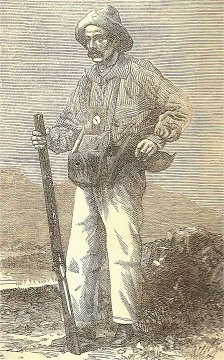 Paul Belloni
du Chaillu (du shay’ yu) (c.1831 or July 31, 1835 – April 29, 1903)
A French-American explorer and anthropologist in Africa. Born probably
in Paris, he spent his youth on the west coast of Africa, where his father
was a trader in Gabon. There he learned the native languages and became
interested in exploring the interior. Arriving in the United States in
1852, he became a citizen and gained the support of the Philadelphia Academy
of Natural Sciences for an expedition to explore Gabon. On his explorations
(1855-59), he captured many rare birds and animals, some of them previously
unknown to science. He brought back the first gorillas to be seen in America.
He became famous in the 1860s as the first modern outsider to confirm the
existence of gorillas and the Pygmy people of central Africa. He later
researched the prehistory of Scandinavia. Paul Belloni
du Chaillu (du shay’ yu) (c.1831 or July 31, 1835 – April 29, 1903)
A French-American explorer and anthropologist in Africa. Born probably
in Paris, he spent his youth on the west coast of Africa, where his father
was a trader in Gabon. There he learned the native languages and became
interested in exploring the interior. Arriving in the United States in
1852, he became a citizen and gained the support of the Philadelphia Academy
of Natural Sciences for an expedition to explore Gabon. On his explorations
(1855-59), he captured many rare birds and animals, some of them previously
unknown to science. He brought back the first gorillas to be seen in America.
He became famous in the 1860s as the first modern outsider to confirm the
existence of gorillas and the Pygmy people of central Africa. He later
researched the prehistory of Scandinavia.
Early life
In his youth he accompanied his father, a French trader in the employment
of a Parisian firm, to the west coast of Africa. Here, at a station on
the Gabon, he was educated by missionaries, and acquired an interest in
and knowledge of the country, its natural history, its natives, and their
languages.
Africa
He was sent in 1855 by the Academy of Natural Sciences at Philadelphia
on an African expedition. Until 1859 he explored the regions of West Africa
in the neighborhood of the equator, gaining considerable knowledge of the
delta of the Ogowe River and the estuary of the Gabon. During his travels
from 1856 to 1859 he observed numerous gorillas, known to non-locals in
prior centuries only from an unreliable report by Hanno the Navigator of
Carthage in the 5th century BC, and known to scientists in the preceding
years only by a few skeletons. He brought back dead specimens, and presented
himself as the first white person to have seen them.
A subsequent expedition, from 1863 to 1865, enabled him to confirm the
accounts given by the ancients of a pygmy people inhabiting the African
forests. Du Chaillu sold his hunted gorillas to the Natural History Museum
in London and his "cannibal skulls" to other European collections. (A fine
cased group shot by du Chaillu may be seen in Ipswich Museum in Suffolk,
England.) Narratives of both expeditions were published, in 1861 and 1867
respectively, under the titles Explorations and Adventures in Equatorial
Africa, with Accounts of the Manners and Customs of the People, and of
the Chace of the Gorilla, Crocodile, and other Animals; and A Journey
to Ashango-land, and further penetration into Equatorial Africa. While
in Ashango Land in 1865 he was elected King of the Apingi tribe.
At the time, he was in great demand on the public lecture circuits of
New York, London, and Paris. Although there were initial challenges of
his accounts, they came be accepted, although Encyclopedia Britannica speculated
that "possibly some of the adventures he described as happening to himself
were reproductions of the hunting stories of natives."
Northern Europe
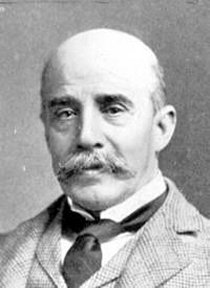 After some
years residence in America, during which he wrote several books for the
young founded upon his African adventures, du Chaillu turned his attention
to northern Europe. After a visit to northern Norway in 1871, over the
following five years he made a study of customs and antiquities in Sweden,
Norway, Lapland and Northern Finland. He published in 1881 The Land
of the Midnight Sun (dedicated to his friend Robert Winthrop of New
York), as a series of Summer and Winter Journeys, in two volumes. After some
years residence in America, during which he wrote several books for the
young founded upon his African adventures, du Chaillu turned his attention
to northern Europe. After a visit to northern Norway in 1871, over the
following five years he made a study of customs and antiquities in Sweden,
Norway, Lapland and Northern Finland. He published in 1881 The Land
of the Midnight Sun (dedicated to his friend Robert Winthrop of New
York), as a series of Summer and Winter Journeys, in two volumes.
His 1889 work The Viking Age (also in two volumes) was a very
broad study of the early history, manners, and customs of the ancestors
of the English-speaking nations. He labored for eight and a half years
and carefully read hundreds of Sagas that describe the life of the people
who inhabited the Scandinavian peninsula from the Stone Age to the Middle
Ages (including literary remains). This scholarly work demonstrates what
is now generally recognised, the importance of the Norse, including Norway,
Sweden, and Denmark to the cultural dimension and transformation of British
Isles during the fifth to eleventh centuries. This view was then unfamiliar
and was ridiculed by Canon Isaac Taylor. This book (in two volumes) is
now a very collectible item. In 1900 he also published The Land of the
Long Night.
He died following a stroke of paralysis at St. Petersburg, while on
his way home from Russia. He is interred under an unusual grave marker
at Woodlawn Cemetery in Bronx, NY.
The National Geographic
Magazine
July 1903 issue: Volume 14, Number 7, pages 282-285.
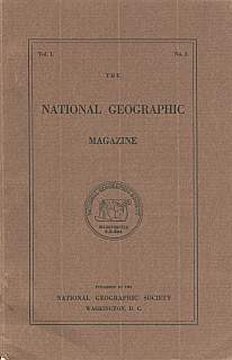 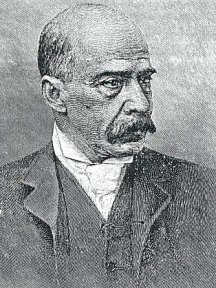 PAUL BELLONI DU CHAILLU, who died at St Petersburg April 30, was
born in New Orleans July 31, 1835. His birthplace was thus the same city
to which Stanley nearly twenty years later drifted as a cabinboy, to be
befriended and adopted by the merchant Stanley. Little is known of Du Chaillu's
ancestors, except that they were of one of the old French Huguenot families
that had settled in Louisiana. His father, a man of considerable means,
was engaged in the West African trade and owned a "factory" or trading
depot on the Gabon coast, a few miles north of the Equator. Paul as a boy
accompanied his father to Africa and lived for three or four years on the
coast. He was a bright, enterprising youngster, who spent most of his time
talking with the natives, hearing their stories and learning their dialects
and ways of thinking and living. He liked better to listen to the stories
of the native traders than to learn the business of his father. It was
this personal knowledge of the native which enabled him afterward to travel
for thousands of miles in the interior without being obliged to kill a
single native.
PAUL BELLONI DU CHAILLU, who died at St Petersburg April 30, was
born in New Orleans July 31, 1835. His birthplace was thus the same city
to which Stanley nearly twenty years later drifted as a cabinboy, to be
befriended and adopted by the merchant Stanley. Little is known of Du Chaillu's
ancestors, except that they were of one of the old French Huguenot families
that had settled in Louisiana. His father, a man of considerable means,
was engaged in the West African trade and owned a "factory" or trading
depot on the Gabon coast, a few miles north of the Equator. Paul as a boy
accompanied his father to Africa and lived for three or four years on the
coast. He was a bright, enterprising youngster, who spent most of his time
talking with the natives, hearing their stories and learning their dialects
and ways of thinking and living. He liked better to listen to the stories
of the native traders than to learn the business of his father. It was
this personal knowledge of the native which enabled him afterward to travel
for thousands of miles in the interior without being obliged to kill a
single native.
About 1853 his father took him back to the United States, but the wild
tales the boy had heard had fascinated him and excited him to find out
how much was true of what the seacoast natives said of the cannibals, pygmies,
wildmen or gorillas, and other marvels of the Great Forest. No white man
had previously penetrated more than a few miles into the interior along
this part of the coast.
In the fall of 1856 he sailed from New York in a three-masted schooner
and was landed at Gabon in December. The following three and one-half years
he passed exploring a section of Africa stretching from Gabon 320 miles
inland and 250 miles north and south. On his return to New York in 1859
he wrote the story of his discoveries, which was published by Harper &
Brothers in 1861 under the title of Explorations and Adventures in Equatorial
Africa; with Accounts of the Manners and Customs of the People, and of
the Chase of the Gorilla, Crocodile, Leopard, Elephant, Hippopotamus, and
other Animals. By Paul B. Du Chaillu, with Map and Illustrations. Harper
& Bros., 1861. In his preface he states: "I traveled - always on foot,
and unaccompanied by other white men - about 8,000 miles. I shot, stuffed,
and brought home over 2,000 birds, of which more than 60 are new species,
and I killed upwards of 1,000 quadrupeds, of which 200 were stuffed and
brought home, with more than 60 hitherto unknown to science. I suffered
fifty attacks of the African fever, taking, to cure myself, more than fourteen
ounces of quinine. Of famine, long-continued exposures to the heavy tropical
rains, and attacks of ferocious ants and venomous flies, it is not worth
while to speak. My two most severe and trying tasks were the transportation
of my numerous specimens to the seashore and the keeping of a daily journal,
both of which involved more painful care than I like even to think of."
In the book he told of gorilla, of which he had brought back the first
specimens and which he had been the first white man to see and hunt; of
the fierce cannibal tribes, the Fans, who filed their teeth to keep them
sharp; of the ravages of the Baskouay ants, which marched in dense columns
miles in length, and who were marshalled by officers and generals; of hunting
elephants with pitfalls; of a new variety of snake, less than four feet
long and six and eight inches thick, which lies in the open places in the
woods and whose bite is instantaneous death, and of many other equally
wonderful sights.
The book was greeted with shouts of laughter and derision from one end
of the American continent to the other. Mr and Mrs and Miss Gorilla was
the common jest, and the name Du Chaillu became a byword for a fanciful
storyteller. Du Chaillu was only 26 when his first book was published.
He was unable to answer satisfactorily the storm of questions hurled at
him; consequently nobody believed him, except Harper and Brothers in the
United States and the Royal Geographical Society in England, both of whom
valiantly and vigorously defended his truthfulness.
In 1863-'65 Du Chaillu made a second journey of exploration to Africa,
the narrative of which appeared in 1867 as "A Journey through Ashango Land."
This time he discovered the pygmies of the Dark Forest, but his descriptions
of the little people were likewise received with incredulity. With this
journey his explorations in Africa ended.
Gradually each of Du Chaillu's discoveries was confirmed by later explorers
- by Schweinfürth, Stanley, Sir Harry Johnston, and others. Many years
ago they were all verified; but the name Du Chaillu none the less still
remains to most Americans that of a romance. In a certain sense Du Chaillu
is himself responsible for this feeling, for all his descriptions are so
vivid and are so thrillingly told that the reader feels he is reading a
work of pure invention, rather than a narrative of actual experience.
His famous description of the first gorilla shot by a white man is worth
quoting: "Suddenly, as we were yet creeping along, in a silence which made
a heavy breath seem loud and distinct, the woods were at once filled with
the tremendous barking roar of the gorilla. Then the underbrush swayed
rapidly just ahead, and presently before us stood an immense male gorilla.
He had gone through the jungle on his all-fours; but when lie saw our party
he erected himself and looked us boldly in the face. He stood about a dozen
yards from us, and was a sight I think I shall never forget. Nearly six
feet high (he proved four inches shorter), with immense body, huge chest,
and great muscular arms, with fiercely-glaring, large, deep gray eyes,
and a hellish expression of face, which seemed to me like some nightmare
vision: thus stood before us this king of the African forest. He was not
afraid of us. He stood there, and beat his breast with his huge fists till
it resounded like an immense bass-drum, which is their mode of offering
defiance; meantime giving vent to roar after roar.
"The roar of the gorilla is the most singular and awful noise heard
in these African woods. It begins with a sharp bark, like an angry dog;
then glides into a deep bass roll, which literally and closely resembles
the roll of distant thunder along the sky, for which I have sometimes been
tempted to take it where I did not see the animal. So deep is it that it
seems to proceed less from the mouth and throat than from the deep chest
and vast paunch.His eyes began to flash fiercer fire as we stood motionless
on the defensive, and the crest of short hair which stands on his forehead
began to twitch rapidly up and down, while his powerful fangs were shown
as he again sent forth a thunderous roar. And now truly he reminded me
of nothing but some hellish dream creature - a being of that hideous order,
half-man, half beast - which we find pictured by old artists in some representations
of the infernal regions. He advanced a few steps, then stopped to utter
that hideous roar again; advanced again, and finally stopped when at a
distance of about six yards from us. And here, just as he began another
of his roars, beating his breast in rage, we fired and killed him."
In later years Du Chaillu traveled extensively in Sweden, Norway, Lapland,
Finland, and other countries. He was the originator of the phrases "Land
of the Midnight Sun" and "Land of the Long Night." In 1889 he published
"The Viking Age," his most ambitious work, the result of many years of
special research. He published his first book for young people in 1868,
called [p. 285] "Stories of the Gorilla Country." This was followed by
many other similar books.
Mr Du Chaillu had many friends among the members, of the National Geographic
Society. His last public address in the United States was before the National
Geographic Society, April 12, 1901, on the occasion of a farewell reception
tendered him by the Society on the eve of his departure for Russia. His
first lecture on his return was to have been before the National Geographic
Society.
OBITUARY
click
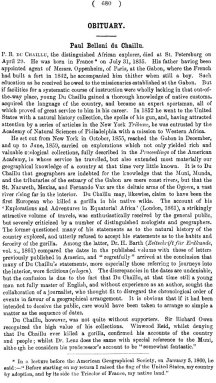
Obituary: Paul Belloni du Chaillu,
The Geographical Journal,
Vol. 21, No. 6 (Jun., 1903), pp. 680-681
The
Baldwin Project: eTexts and Illustrations
Answers.com
Entry
ERBlist.com
Modern
History Sourcebook: Paul du Chaillu: Travels in Africa, 1868-1870 |

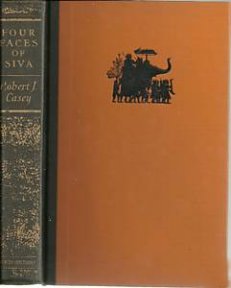
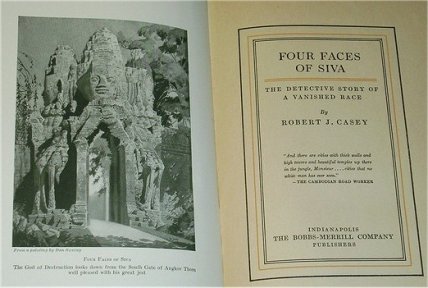
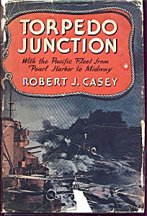
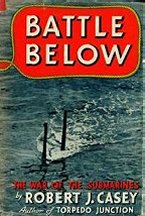 Battle
Below ~ 1945 ~ Stories from WWII submarine warfare which were written
in 1943 and held up by Navy censors until after the war. Hair-raising tales
of risk and survival doing battle beneath the waves.
Battle
Below ~ 1945 ~ Stories from WWII submarine warfare which were written
in 1943 and held up by Navy censors until after the war. Hair-raising tales
of risk and survival doing battle beneath the waves.
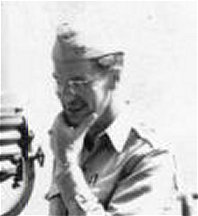
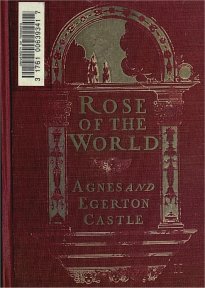
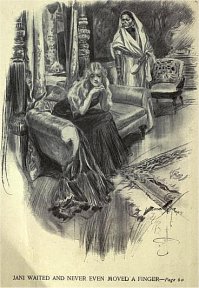
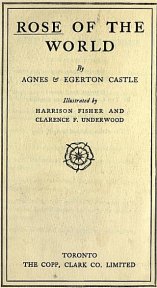
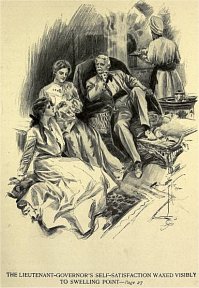
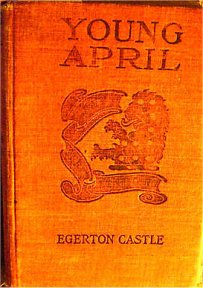
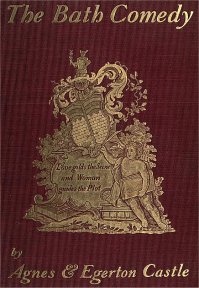

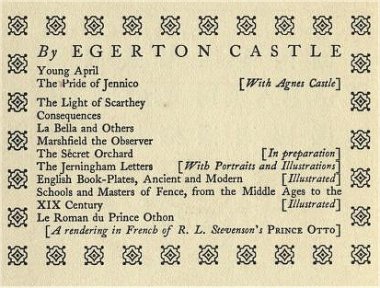
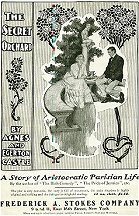
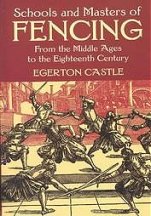
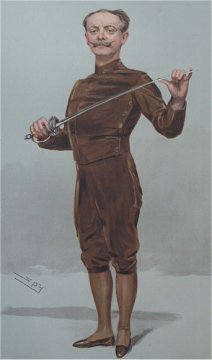 EGERTON
CASTLE: (March 12, 1858-September 16, 1920), English novelist, was
born in London to a wealthy family. His grandfather, Egerton Smith, was
the founder of the Liverpool Mercury, a leading paper in which Castle inherited
an interest. His father, Arthur Michael Castle, had in his youth been friends
with Verdi, Donizetti, Rossini, Liszt, George Sand, Alexander Dumas, Robert
Browning, and many other notable writers, artists, and musicians; he spent
the greater part of his life away from England and made Egerton, his only
son, a constant companion, taking him on walking tours throughout Europe.
"These tours," wrote William Armstrong in the Book Buyer, were "a part
of a rather Spartan system of physical training. . . devised by his father
to supplement deficiencies of the otherwise well-conceived educational
course of the Universite [de Paris]."
EGERTON
CASTLE: (March 12, 1858-September 16, 1920), English novelist, was
born in London to a wealthy family. His grandfather, Egerton Smith, was
the founder of the Liverpool Mercury, a leading paper in which Castle inherited
an interest. His father, Arthur Michael Castle, had in his youth been friends
with Verdi, Donizetti, Rossini, Liszt, George Sand, Alexander Dumas, Robert
Browning, and many other notable writers, artists, and musicians; he spent
the greater part of his life away from England and made Egerton, his only
son, a constant companion, taking him on walking tours throughout Europe.
"These tours," wrote William Armstrong in the Book Buyer, were "a part
of a rather Spartan system of physical training. . . devised by his father
to supplement deficiencies of the otherwise well-conceived educational
course of the Universite [de Paris]."
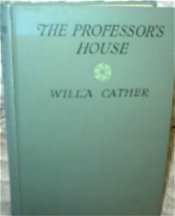 The Professor's
House was published in 1925, only seven years after My Ántonia,
but it is set in an America that is at least a half-century removed from
its frontier past, an America that sells off its heritage while buying
up the relics of European antiquity. Its protagonist, Godfrey St. Peter,
might be an older version of Jim Burden. He is a man who grew up on the
prairie, entered academia and in his fifties has attained professional
success and what at first seems to be domestic happiness. But over the
year in which the novel's events transpire--the year that follows his family's
move to a new house and ends with his near-death in the old one he has
refused to abandon--it becomes clear that St. Peter's success is hollow,
his relations with his wife and children passionless and embittered. What
meaning remains in the professor's life lies in the past, in his relationship
with a gifted pupil who died young and whose discoveries have made St.
Peter's family wealthy--but at an awful cost. "If Outland were here tonight,"
St. Peter thinks, "he might say with Mark Antony, My fortunes have corrupted
honest men." If the tone of My Ántonia is that of the romantic pastoral,
The Professor's House is a bleaker--and at times even a savage--book. In
place of Jim Burden's rhapsodic concluding vision, we are left with St.
Peter's realization that "He had never learned to live without delight.
And he would have to learn to, just as, in a Prohibition country, he supposed
he would have to learn to live without sherry. Theoretically he knew that
life is possible, may be even pleasant, without joy, without passionate
griefs. But it had never occurred to him that he might have to live like
that.
The Professor's
House was published in 1925, only seven years after My Ántonia,
but it is set in an America that is at least a half-century removed from
its frontier past, an America that sells off its heritage while buying
up the relics of European antiquity. Its protagonist, Godfrey St. Peter,
might be an older version of Jim Burden. He is a man who grew up on the
prairie, entered academia and in his fifties has attained professional
success and what at first seems to be domestic happiness. But over the
year in which the novel's events transpire--the year that follows his family's
move to a new house and ends with his near-death in the old one he has
refused to abandon--it becomes clear that St. Peter's success is hollow,
his relations with his wife and children passionless and embittered. What
meaning remains in the professor's life lies in the past, in his relationship
with a gifted pupil who died young and whose discoveries have made St.
Peter's family wealthy--but at an awful cost. "If Outland were here tonight,"
St. Peter thinks, "he might say with Mark Antony, My fortunes have corrupted
honest men." If the tone of My Ántonia is that of the romantic pastoral,
The Professor's House is a bleaker--and at times even a savage--book. In
place of Jim Burden's rhapsodic concluding vision, we are left with St.
Peter's realization that "He had never learned to live without delight.
And he would have to learn to, just as, in a Prohibition country, he supposed
he would have to learn to live without sherry. Theoretically he knew that
life is possible, may be even pleasant, without joy, without passionate
griefs. But it had never occurred to him that he might have to live like
that.
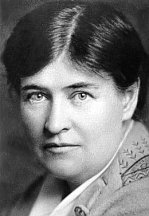
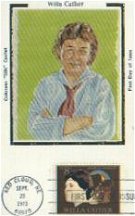
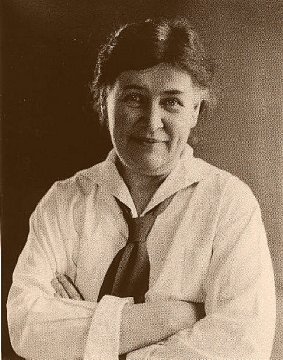 In
1925 she explained that she did not want to become too identified with
the West, for "using one setting all the time is very like planting a field
with corn season after season. I believe in rotation of crops. If the public
ties me down to the cornfield too much I'm afraid I'll leave that scene
entirely." And leave she did, to write novels set in Michigan, the American
Southwest, and Quebec. Cather's themes, too, changed during this period,
as she turned from the passion of individuals aspiring to greatness and
began writing of compassion of ordinary people who, confronting mortality,
seek comfort in the human family. In the end, Cather returned to her earliest
memories to write again of Nebraska and, in her last book, of Virginia.
But unlike the sunny themes of her early novels drawn from childhood memories,
"Lucy Gayheart" and "Sapphira and the Slave Girl" are Gothic stories in
which dark passions break through the apparent calm of everyday lives.
For during her final years Cather felt the horror of events leading to
another world war, the pain over deaths of family and friends, and the
frustration from an inflammation of her hand that meant an inability to
write. But she also maintained old friendships and enjoyed new ones, most
importantly with the Menuhin children; and she continued to write, publishing
short stories (e.g. "The Best Years") and working on an Avignon novel that
remained unfinished at the time of her death. She died of a cerebral hemorrhage
on April 24, 1947. Cather's life is remarkable for the faith that she kept
-- to her family; her friends (she lived with Edith Lewis for thirty-eight
years); her first editor, Ferris Greenslet, at Houghton Mifflin; her publisher,
Alfred Knopf, to whom she went following "My Antonia" and with whom she
remained the rest of her life; and most of all to her art. As her biographer
James Woodress has written, she lived "a literary life," with "a single-minded
dedication to the pursuit of art" (Willa Cather: A Literary Life, xvi).
Awards came to Cather during her life time -- honorary degrees from numerous
universities, the Pulitzer Prize for "One of Ours," a medal by the American
Academy for "Death Comes for the Archbishop," and the gold medal from the
National Institute of Arts and Letters for a writer's lifetime achievement.
Following her death, her reputation has grown steadily and, in the last
fifteen years, exploded with activity, with over a hundred articles and
several books appearing each year on her. In 1990 "A Lost Lady" was included
among the Encyclopedia Britannica's "Great Books of the Western World,"
and Cather is now widely recognized as a major American writer, and our
country's foremost woman writer. But more telling than such accolades,
Willa Cather's novels have never gone out of print, for her popular following
has remained strong. So the explosion of critical recognition means only
that the experts have realized what her readers have known all along --
that Willa Cather's novels and stories, in such apparently simple style,
provide companionship for a lifetime.
In
1925 she explained that she did not want to become too identified with
the West, for "using one setting all the time is very like planting a field
with corn season after season. I believe in rotation of crops. If the public
ties me down to the cornfield too much I'm afraid I'll leave that scene
entirely." And leave she did, to write novels set in Michigan, the American
Southwest, and Quebec. Cather's themes, too, changed during this period,
as she turned from the passion of individuals aspiring to greatness and
began writing of compassion of ordinary people who, confronting mortality,
seek comfort in the human family. In the end, Cather returned to her earliest
memories to write again of Nebraska and, in her last book, of Virginia.
But unlike the sunny themes of her early novels drawn from childhood memories,
"Lucy Gayheart" and "Sapphira and the Slave Girl" are Gothic stories in
which dark passions break through the apparent calm of everyday lives.
For during her final years Cather felt the horror of events leading to
another world war, the pain over deaths of family and friends, and the
frustration from an inflammation of her hand that meant an inability to
write. But she also maintained old friendships and enjoyed new ones, most
importantly with the Menuhin children; and she continued to write, publishing
short stories (e.g. "The Best Years") and working on an Avignon novel that
remained unfinished at the time of her death. She died of a cerebral hemorrhage
on April 24, 1947. Cather's life is remarkable for the faith that she kept
-- to her family; her friends (she lived with Edith Lewis for thirty-eight
years); her first editor, Ferris Greenslet, at Houghton Mifflin; her publisher,
Alfred Knopf, to whom she went following "My Antonia" and with whom she
remained the rest of her life; and most of all to her art. As her biographer
James Woodress has written, she lived "a literary life," with "a single-minded
dedication to the pursuit of art" (Willa Cather: A Literary Life, xvi).
Awards came to Cather during her life time -- honorary degrees from numerous
universities, the Pulitzer Prize for "One of Ours," a medal by the American
Academy for "Death Comes for the Archbishop," and the gold medal from the
National Institute of Arts and Letters for a writer's lifetime achievement.
Following her death, her reputation has grown steadily and, in the last
fifteen years, exploded with activity, with over a hundred articles and
several books appearing each year on her. In 1990 "A Lost Lady" was included
among the Encyclopedia Britannica's "Great Books of the Western World,"
and Cather is now widely recognized as a major American writer, and our
country's foremost woman writer. But more telling than such accolades,
Willa Cather's novels have never gone out of print, for her popular following
has remained strong. So the explosion of critical recognition means only
that the experts have realized what her readers have known all along --
that Willa Cather's novels and stories, in such apparently simple style,
provide companionship for a lifetime.
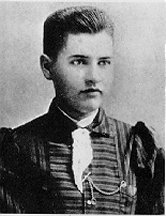 Born Wilella
Siebert Cather in 1873 on a small farm in the Back Creek valley near Winchester,
Virginia. Her father was Charles Fectigue Cather (d. 1928), whose family
had lived on land in the valley for six generations. Her mother was Mary
Virginia Boak (d. 1931). Mary had six more children after Willa: Roscoe,
Douglass, Jessica, James, John, and Elsie. In 1883, Cather moved with her
family to Catherton in Webster County, Nebraska. The following year the
family relocated to Red Cloud, the county seat. Cather spent the rest of
her childhood in the town which she later made famous by her writing career.
When Willa Cather insisted on attending college, her family borrowed money
for her to attend the University of Nebraska.
Born Wilella
Siebert Cather in 1873 on a small farm in the Back Creek valley near Winchester,
Virginia. Her father was Charles Fectigue Cather (d. 1928), whose family
had lived on land in the valley for six generations. Her mother was Mary
Virginia Boak (d. 1931). Mary had six more children after Willa: Roscoe,
Douglass, Jessica, James, John, and Elsie. In 1883, Cather moved with her
family to Catherton in Webster County, Nebraska. The following year the
family relocated to Red Cloud, the county seat. Cather spent the rest of
her childhood in the town which she later made famous by her writing career.
When Willa Cather insisted on attending college, her family borrowed money
for her to attend the University of Nebraska.
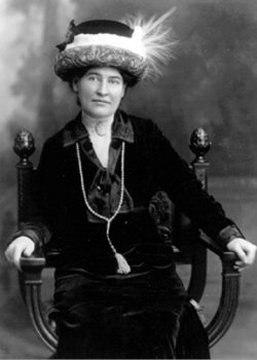 Cather moved
to join the editorial staff of McClure's and in 1908 was promoted to managing
editor. As a journalist, she co-authored, alongside Georgina M. Wells,
a critical biography of Mary Baker Eddy, the founder of Christian Science.
It was serialized in McClure's in 1907-8 and published the next year as
a book. Christian Scientists were outraged and tried to buy every copy.The
Syracuse Herald, Sat. Eve. 2 Mar 1907, Pg 7, Col 5-7 The work was reprinted
by the University of Nebraska Press in 1993.In 1942 cather moved out In
New York Cather met a variety of authors. Sarah Orne Jewett advised her
to rely less on the influence of Henry James and more on her own experiences
in Nebraska. For her novels, Cather returned to the prairie for inspiration
and also drew on her experiences in France. These works became both popular
and critical successes.
Cather moved
to join the editorial staff of McClure's and in 1908 was promoted to managing
editor. As a journalist, she co-authored, alongside Georgina M. Wells,
a critical biography of Mary Baker Eddy, the founder of Christian Science.
It was serialized in McClure's in 1907-8 and published the next year as
a book. Christian Scientists were outraged and tried to buy every copy.The
Syracuse Herald, Sat. Eve. 2 Mar 1907, Pg 7, Col 5-7 The work was reprinted
by the University of Nebraska Press in 1993.In 1942 cather moved out In
New York Cather met a variety of authors. Sarah Orne Jewett advised her
to rely less on the influence of Henry James and more on her own experiences
in Nebraska. For her novels, Cather returned to the prairie for inspiration
and also drew on her experiences in France. These works became both popular
and critical successes.
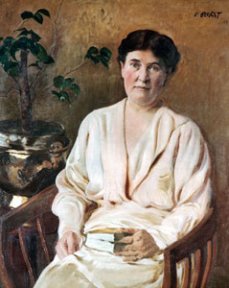 Throughout Cather's
adult life, her most significant relationships were with women. These included
her college friend, Louise Pound; the Pittsburgh socialite, Isabelle McClung,
with whom Cather traveled to Europe; opera singer Olive Fremstad; and most
notably, the editor Edith Lewis. Cather's sexual identity remains, however,
a point of contention amongst scholars with many arguing for Cather as
a lesbian and interpreting her work through a lens of queer theory while
a highly vocal contingent of Cather scholars adamantly oppose such considerations.
Throughout Cather's
adult life, her most significant relationships were with women. These included
her college friend, Louise Pound; the Pittsburgh socialite, Isabelle McClung,
with whom Cather traveled to Europe; opera singer Olive Fremstad; and most
notably, the editor Edith Lewis. Cather's sexual identity remains, however,
a point of contention amongst scholars with many arguing for Cather as
a lesbian and interpreting her work through a lens of queer theory while
a highly vocal contingent of Cather scholars adamantly oppose such considerations.
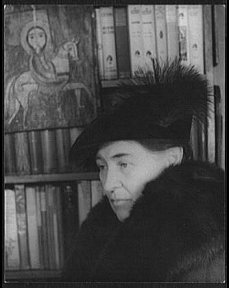 Cather received
both national and state honors. In 1973, the United States Postal Service
honored Willa Cather by using her image on a postage stamp. In 1981 the
U.S. Mint created the Willa Cather medallion, a half-ounce gold coin. Willa
Cather half-ounce gold coin.Cather was elected to the Nebraska Hall of
Fame. In 1986, Cather was inducted into the National Cowgirl Museum and
Hall of Fame. Her alma mater, the University of Nebraska, named residence
halls after both Cather and her college friend, Louise Pound. Pound had
a lifelong career as professor of English at the university and was the
first woman president of the Modern Language Association. The Willa Cather
Pioneer Memorial and Educational Foundation (now the Willa Cather Foundation)
was founded in 1955 to support the study of her life and work and the maintain
many sites in her hometown of Red Cloud, Nebraska.
Cather received
both national and state honors. In 1973, the United States Postal Service
honored Willa Cather by using her image on a postage stamp. In 1981 the
U.S. Mint created the Willa Cather medallion, a half-ounce gold coin. Willa
Cather half-ounce gold coin.Cather was elected to the Nebraska Hall of
Fame. In 1986, Cather was inducted into the National Cowgirl Museum and
Hall of Fame. Her alma mater, the University of Nebraska, named residence
halls after both Cather and her college friend, Louise Pound. Pound had
a lifelong career as professor of English at the university and was the
first woman president of the Modern Language Association. The Willa Cather
Pioneer Memorial and Educational Foundation (now the Willa Cather Foundation)
was founded in 1955 to support the study of her life and work and the maintain
many sites in her hometown of Red Cloud, Nebraska.
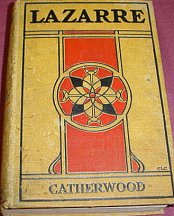
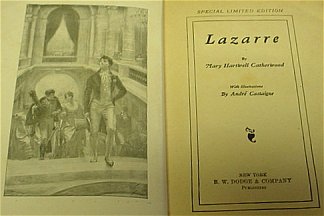
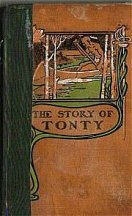

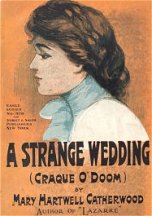
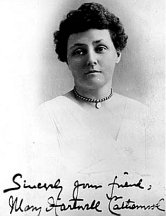
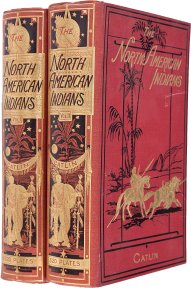
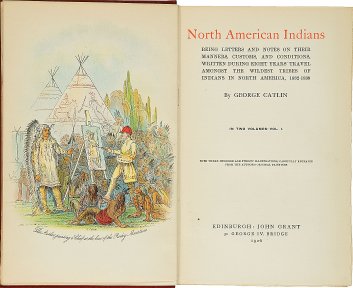
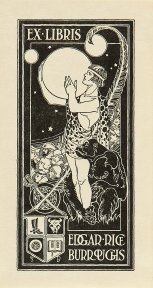
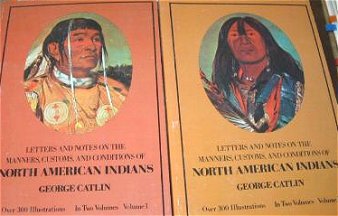 ~
If
Meriwether Lewis and William Clark were the first white Americans to explore
the west half of the continent, from the Mississippi at St Louis to the
northwest Pacific coast, George Catlin travelled at least as many miles
on his journeys by canoe and horse from Minnesota and the Montana border
south to eastern Texas, as well as forays to the Gulf states and South
Carolina, seeking to record the Indians in paintings and journals. Taken
together, Catlin’s works constitute the first, last and only complete record
of the Plains Indians ever made at the height of their splendid culture,
so soon destroyed by traders’ liquor and disease, rapine and bayonets.
Because Catlin perceived his colourful subjects as human beings, worthy
of criticism and gentle ridicule as well as profound admiration, his people
are unromanticized and never stereotyped, neither in his paintings nor
in his prose.
~
If
Meriwether Lewis and William Clark were the first white Americans to explore
the west half of the continent, from the Mississippi at St Louis to the
northwest Pacific coast, George Catlin travelled at least as many miles
on his journeys by canoe and horse from Minnesota and the Montana border
south to eastern Texas, as well as forays to the Gulf states and South
Carolina, seeking to record the Indians in paintings and journals. Taken
together, Catlin’s works constitute the first, last and only complete record
of the Plains Indians ever made at the height of their splendid culture,
so soon destroyed by traders’ liquor and disease, rapine and bayonets.
Because Catlin perceived his colourful subjects as human beings, worthy
of criticism and gentle ridicule as well as profound admiration, his people
are unromanticized and never stereotyped, neither in his paintings nor
in his prose.
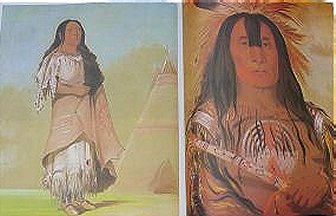
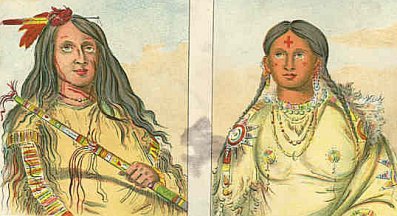
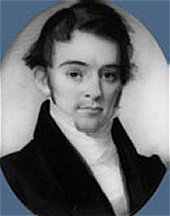
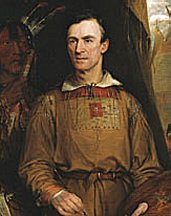
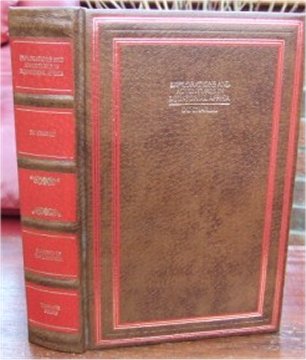
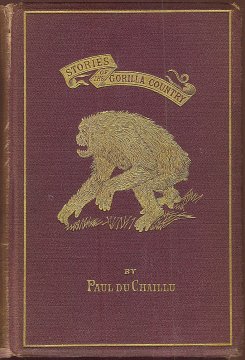
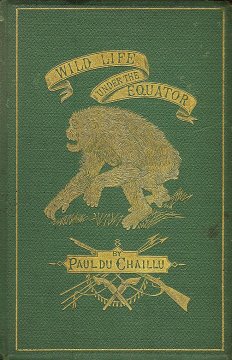
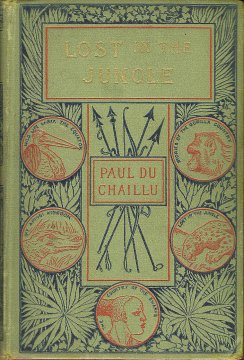
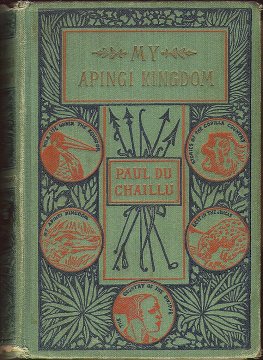
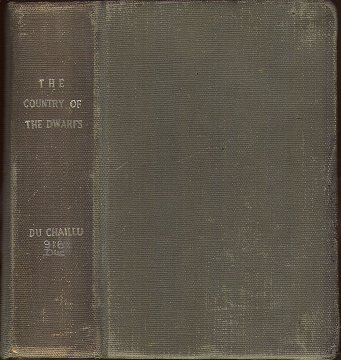
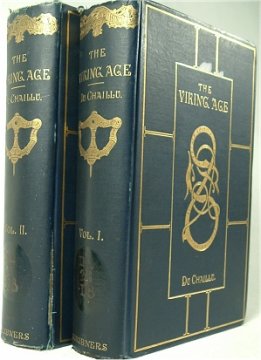

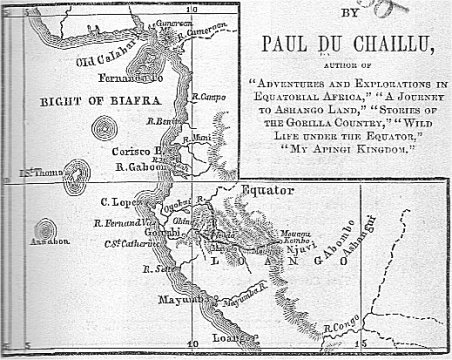
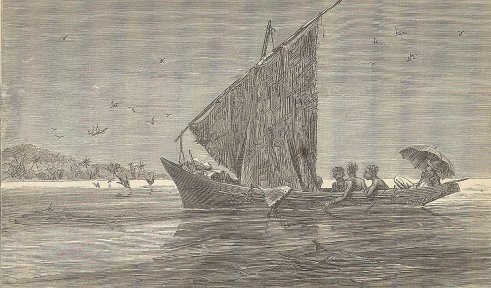
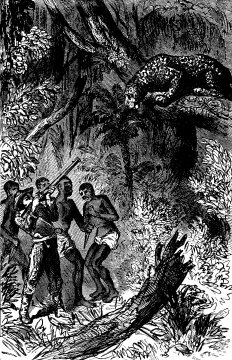
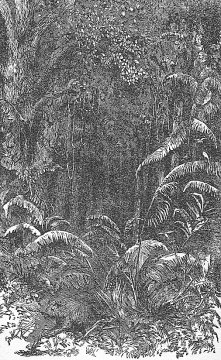
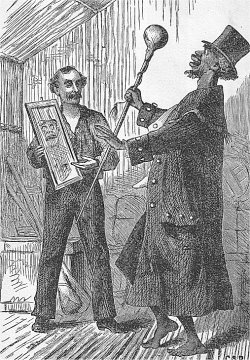
 Paul Belloni
du Chaillu (du shay’ yu) (c.1831 or July 31, 1835 – April 29, 1903)
A French-American explorer and anthropologist in Africa. Born probably
in Paris, he spent his youth on the west coast of Africa, where his father
was a trader in Gabon. There he learned the native languages and became
interested in exploring the interior. Arriving in the United States in
1852, he became a citizen and gained the support of the Philadelphia Academy
of Natural Sciences for an expedition to explore Gabon. On his explorations
(1855-59), he captured many rare birds and animals, some of them previously
unknown to science. He brought back the first gorillas to be seen in America.
He became famous in the 1860s as the first modern outsider to confirm the
existence of gorillas and the Pygmy people of central Africa. He later
researched the prehistory of Scandinavia.
Paul Belloni
du Chaillu (du shay’ yu) (c.1831 or July 31, 1835 – April 29, 1903)
A French-American explorer and anthropologist in Africa. Born probably
in Paris, he spent his youth on the west coast of Africa, where his father
was a trader in Gabon. There he learned the native languages and became
interested in exploring the interior. Arriving in the United States in
1852, he became a citizen and gained the support of the Philadelphia Academy
of Natural Sciences for an expedition to explore Gabon. On his explorations
(1855-59), he captured many rare birds and animals, some of them previously
unknown to science. He brought back the first gorillas to be seen in America.
He became famous in the 1860s as the first modern outsider to confirm the
existence of gorillas and the Pygmy people of central Africa. He later
researched the prehistory of Scandinavia.
 After some
years residence in America, during which he wrote several books for the
young founded upon his African adventures, du Chaillu turned his attention
to northern Europe. After a visit to northern Norway in 1871, over the
following five years he made a study of customs and antiquities in Sweden,
Norway, Lapland and Northern Finland. He published in 1881 The Land
of the Midnight Sun (dedicated to his friend Robert Winthrop of New
York), as a series of Summer and Winter Journeys, in two volumes.
After some
years residence in America, during which he wrote several books for the
young founded upon his African adventures, du Chaillu turned his attention
to northern Europe. After a visit to northern Norway in 1871, over the
following five years he made a study of customs and antiquities in Sweden,
Norway, Lapland and Northern Finland. He published in 1881 The Land
of the Midnight Sun (dedicated to his friend Robert Winthrop of New
York), as a series of Summer and Winter Journeys, in two volumes.











